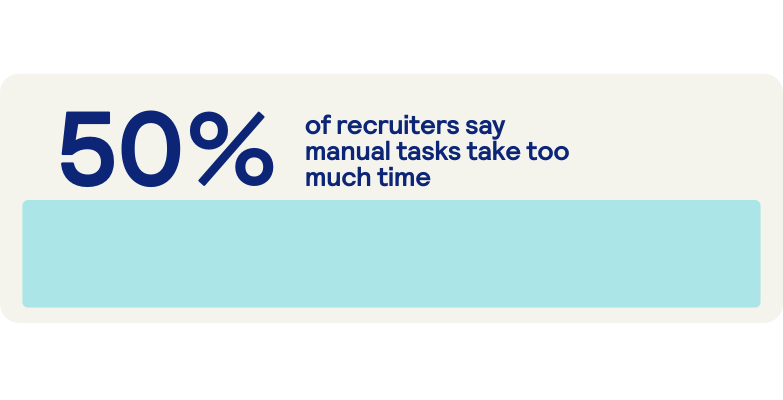
Top 8 ChatGPT prompts for recruiters
Table of Contents
- Why ChatGPT matters
- 8 best ChatGPT prompts
- Getting the most out of ChatGPT
- ChatGPT and human insight
- FAQs

How to Improve Job Application Quality
Recruitment can be a challenge for organisations of any size. SMEs in particularly may sometimes struggle to balance the investment of time and money needed to hire successfully while staying lean and agile.
Luckily, if you’re a recruiter facing this challenge, the improvements to artificial intelligence (AI) over the past few years mean you can take advantage of a technology that can save your organisation time and money. In fact, Totaljobs research found AI is already helping 77% of recruiters to improve efficiency in hiring.

Recruiter Templates
Leading the way in AI is ChatGPT. In this article, we’ll be exploring why tools like ChatGPT are so useful in recruitment and how to get the best out of them.
Why recruiters should care about ChatGPT
Recruitment requires a lot of work, much of which is time-consuming and repetitive.
For example, Totaljobs research found that, on average recruiters hire for four roles a month, with at least 20 applications for each vacancy. Recruiters told us they spend around 3.6 hours screening CVs per vacancy, with 72% saying only half of the applications they received even qualified to go on to the next step of the process.
All of this time can add up to as much as £16,728 per year of time-intensive screening work that could be better focused elsewhere.
23%
of recruiters are unsure about using AI in the hiring process
If you’re still on the fence about using AI in recruitment, you’re not alone. Our research shows almost a quarter of recruiters are unsure about using it due to unfamiliarity and mistrust.

Here’s the truth: AI tools like ChatGPT can revolutionise recruitment processes. It’s not about taking the humanity out of the process, but about using another tool to get more work done, quicker, at a lower cost to your organisation’s bottom line.
Let’s take a quick look at some of the key advantages and opportunities.
Automation
ChatGPT can handle repetitive tasks that typically take up valuable time, such as:
- Drafting standard emails
- Scheduling candidate interviews
By automating these routine actions, you can save time and shift focus to more strategic, high-value work.
Enhanced productivity
Recruiters can use ChatGPT as an assistant to summarise lengthy CVs (provided any personal data/information is removed) to quickly identify whether a candidate has the key skills required for a specific role, get it to draft exciting job ads that will hook top candidates, and even generate interview questions based on a detailed prompt.
Crucially, ChatGPT should be used for summarising or drafting frameworks, not for making evaluation decisions. Recruiters should always make the final call to ensure fairness, compliance, and a human-centred approach.
Collaborative intelligence
ChatGPT can be a collaborative partner in the recruitment process, helping to co-develop key resources.
One example of how this can work is co-developing interview scorecards to ensure a fair and consistent evaluation of all candidates. Here too, ChatGPT should only be used to draft templates or frameworks. Recruiters bring the judgement, nuance, and legal compliance needed to ensure decisions are fair and effective.
ChatGPT can help outline a shared understanding of what success looks like for a role, aligning the entire hiring team.
What to watch out for when using ChatGPT
Before we look at the ChatGPT prompts for recruiters, it’s worth having a quick think about the potential pitfalls with AI.
So, when integrating AI into recruitment workflows, talent acquisition and HR professionals should consider:
- Compliance: Ensure AI-generated content complies with organisational policies and data handling regulations.
- Inclusivity: AI models can sometimes perpetuate biases present in their training data. Review all generated content to check it uses inclusive language and does not unintentionally discriminate against any group of candidates.
- GDPR: UK-based recruiters have to be hyper-aware of GDPR. This means you should not be feeding any sensitive, personally identifiable candidate information into any third-party AI tool that operates outside your organisation’s secure data environment.
8 best ChatGPT prompts for recruiters
Now it’s time to explore eight of the most powerful ChatGPT prompts you can use to put a rocket under your recruitment process.
We’ve included example job titles and industries for each one, so just swap out the relevant parts for your specific recruitment needs.
Let’s dive in.
1. Candidate sourcing blueprint
Prompt: “You’re a recruiter with 5+ years of experience in UK tech hiring. Outline a senior backend engineer profile, including relevant skills, job titles, typical employers, and online hotspots.”
Follow-up prompt: “Now turn this candidate profile into three Boolean search strings that a recruiter could use on general search engines or within job boards. Include variations of job titles, must-have skills, and location filters for the UK market.”
These prompts can help you pinpoint where and how to look for top talent. This combination saves significant time by moving you from a broad idea to a precise search query in seconds.
Here’s an example of a Boolean search string ChatGPT might produce:
“(Senior OR Lead) AND (“Backend Engineer” OR “Software Engineer”) AND (Python OR Java OR Node.js) AND (AWS OR Azure) AND (Microservices OR API) AND (“United Kingdom” OR UK)”
2. Writing job descriptions
Prompt: “Write an inclusive job description for a Senior Content Strategist role in a UK-based SaaS company. Include sections for key responsibilities, required skills, and benefits. The tone should be professional and reflect a forward-thinking, collaborative culture.”
This streamlines a typically time-consuming task. By detailing your company’s culture and specific needs, you get a job description that is accurate and on-brand, helping you attract candidates who are a great cultural fit from the start.
3. Optimising job adverts
Prompt: “Draft an SEO-friendly job advert for a remote Marketing Manager position in the UK. Focus on keywords that a candidate would use in a job search.”
Follow-up prompt: “Rewrite this job advert into a short, candidate-friendly social media post. The tone should be concise and engaging.”
The first prompt will give you a detailed job ad that quality candidates will find thanks to the SEO element. If you have a ‘culture’ or ‘working here’ page on your organisation’s website, you could feed this to ChatGPT too to ensure the culture is reflected in the ad.
The follow-up prompt will take your detailed job ad and instantly turn it into social media posts.
4. Creating candidate personas
Prompt: “You’re a hiring manager for a rapidly growing UK e-commerce startup. Outline a detailed candidate persona for a Head of Growth role, including their key skills, motivations, and the typical challenges they face.”
Candidate personas are powerful tools in your hiring arsenal, and ChatGPT can draft them for you in seconds. Make sure to read over them carefully and adjust the prompt if the results are not right the first time.
5. Outreach messaging
Prompt: “Write a personalised, professional outreach message to a potential candidate for a Product Manager role, referencing their recent post about their favourite productivity tools.”
Follow-up prompt: “Make this message more concise and approachable, reducing the word count by 30% and using a friendlier tone.”
Outreach is a vital part of recruitment, and if you feed ChatGPT the right content from a target’s social media posts, you can create a personalised message in seconds. Be sure check the message carefully before sending on to the candidate, as you want this to sound as human as possible.

Reminder: Avoid inputting personal identifiers or sensitive data when creating outreach drafts. Keep prompts generalised and add the specific details yourself.
6. CV screening
Prompt: “Summarise the key strengths and relevant experience from the following CV for an entry-level Financial Analyst role. Focus only on skills and qualifications mentioned in the job description provided. Highlight if none of these skills or qualifications are apparent.”
This prompt can significantly speed up the initial CV review process. By focusing the AI on key requirements, you can quickly identify the most qualified candidates. However, CVs must always be anonymised before being shared with ChatGPT, and recruiters should make the ultimate screening and evaluation decisions. AI should never replace human judgement in this area.

Reminder: Tools like ChatGPT are best for structuring summaries, but recruiters add the vital context, empathy, and compliance knowledge.
7. Candidate rejection emails
Prompt: “Write a professional and empathetic rejection email for a candidate who was not selected for an interview after applying for a role. The email should be polite and thank them for their time.”
Follow-up prompt: “Rewrite this rejection email with a more encouraging and constructive tone for a senior-level candidate, acknowledging their experience while still declining the application.”
Rejection is tough for candidates, but it can also be hard for recruiters having to write rejection emails. Use these prompts to help you maintain a positive candidate experience and uphold your employer brand.
8. Onboarding welcome messages
Prompt: “Write a warm and welcoming email to a new hire before their first day as a Marketing Coordinator. Include first-day details, a simple agenda, and a brief introduction to the team they’ll be working with.”
This prompt extends the positive candidate experience into the onboarding process. Make sure you add all the relevant details so the AI knows what to include.
Tips for getting the most out of ChatGPT
Here are some key prompting principles you can follow to get the best out of ChatGPT:
- Be specific: The more detail you provide, the better the result. Clearly state the desired length, tone, and structure.
- Add context: Tell the AI who it is and who it is writing for. For example, “You are a recruiter at a UK-based SME writing to a senior candidate.”
- Set the format: Specify how you want the output to be delivered. Ask it to “write as a formal email,” “draft as a bulleted list,” or “generate a social media post.”
- Iterate: Don’t expect perfection on the first try. Use follow-up prompts to tweak the output, such as “make this more concise” or “change the tone to be more approachable.”
- Test: Run the same query with slightly different prompts to see which one works best. Use this to build a library of tried and tested prompts.
Combining ChatGPT with human insight
Ultimately, ChatGPT is a tool to empower recruitment processes, not to replace human recruiters. It’s great at automation and creating drafts in an instant, but human empathy, fairness, and strategic thinking remain crucial. By experimenting with these prompts and building a reusable library, you can augment your skills and focus on the human connections that drive great hiring.

Decoding Global Talent: Work Preferences in the Age of GenAI
Frequently asked questions (FAQs)
How can you use AI in recruiting?
AI can automate many manual tasks, from drafting job descriptions and screening CVs to writing outreach emails and generating interview questions, allowing recruiters to focus on strategic, human-centric work.
How to prompt AI to get the best results?
Be as specific as possible. Tell the AI its role – for example “You are a UK recruiter” – add context, set a clear format, and refine your request with follow-up prompts to get the best output.
What is the best AI tool for recruiters?
There are a few good AI tools, but ChatGPT is a powerful, versatile tool, especially for written tasks. For more advanced, automated features like screening and scheduling, dedicated AI recruiting platforms may be a better fit.
What is the difference between ChatGPT and other recruiting platforms?
ChatGPT is a general-purpose AI chatbot, whereas other platforms like Paradox or Eightfold are specialised AI tools designed specifically for the recruitment process.
Explore articles
Receive the latest recruitment resources and
advice to boost your hiring
By providing us with your details you agree to our privacy policy and for us to keep you updated with the latest news, events,
and special offers from Totaljobs.









